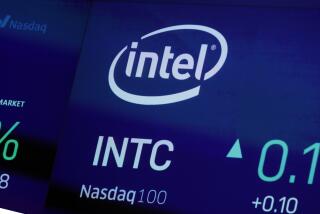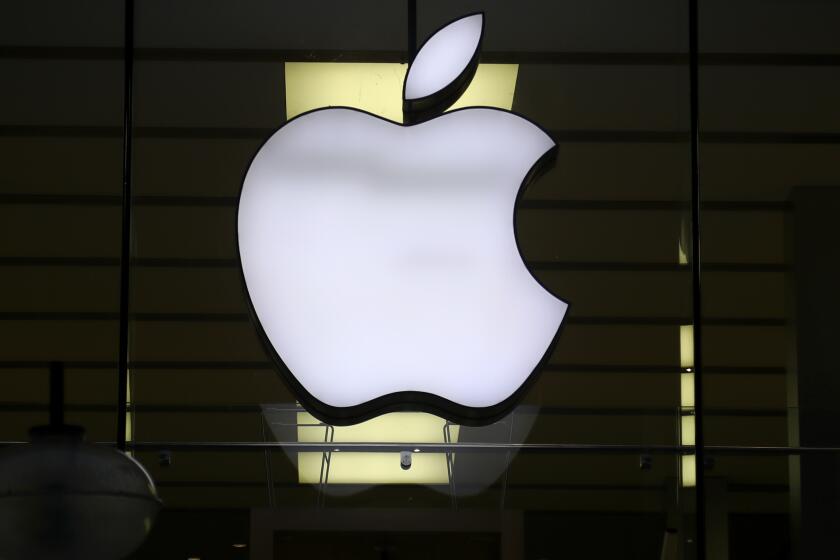The Chips Are Down: Intel Faces Serious Threat to Its Dominance
- Share via
“Intel Inside” is more than ad copy. Intel Corp. so thoroughly dominates the microprocessor industry that the slogan has become a defining reality of personal computing.
Even amid a worldwide semiconductor slump last year, Intel collected a record $26.3 billion in revenue and earned $6.1 billion as its stock soared to record highs.
So why should such a steamroller live by Chairman Andrew Grove’s creed, “Only the paranoid survive”? Perhaps because for the first time in more than a decade, Intel faces a confluence of threats that some experts say could number its days of unchallenged supremacy.
“It’s not only a danger for Intel,” said Nathan Brookwood, an analyst with Insight 64 in Saratoga, Calif. “It’s in the cards.”
Several factors are disrupting the microprocessor marketplace and casting doubts on Intel’s established practices and long-term strategies:
* Federal Trade Commission regulators have sued Intel for allegedly using coercive tactics to control intellectual property that is key to microprocessor innovation and to preserve and extend a microprocessor monopoly. The suit, which goes to trial March 9, could end up limiting Intel’s pervasive influence over the direction of future technologies.
* Some key industry players expect a new world of networked information appliances, such as hand-held computers, Web TV and car navigation systems, to eventually dwarf the PC market and shift the focus of innovation and source of profits. Intel has only a weak presence in that area.
* In 1998, Intel lost nearly half its share in the burgeoning low-cost PC market--dropping from 80% to 46%, according to San Diego analyst group Infobeads. Plummeting PC prices have squeezed the historically stratospheric profit margins that fuel Intel’s vast research and development and marketing efforts.
As recently as 1997, Intel collected 85% of industry revenues for PC central processors, according to Cahners In-Stat Group, a Scottsdale, Ariz., research firm.
“That’s an unnatural state of affairs in any real industry,” Brookwood said. “As the competitors improve their products and their marketing, that’s going to go down.”
And it has--dropping to 80.3% today.
Ironically, the low-cost PC craze made Intel a victim of its own success. For decades, Intel relentlessly proved Moore’s Law--the industry tenet promulgated by Intel co-founder Gordon Moore that projects the doubling of processor power for the same price every 18 to 24 months. As chips became exponentially faster, they eventually eclipsed the demands of most PC software.
That means “for the typical user, higher performance means nothing,” said Michael Hackworth, chairman of chip maker Cirrus Logic.
Intel Loses the Market for Sub-$1,000 PCs
In a rare but costly stumble, Intel failed to foresee that many users would prefer low-cost PCs that still handle typical computing tasks with alacrity over costlier machines based on Intel’s fastest and most lucrative processors. When sub-$1,000 PCs became a dominant trend, Intel lacked a low-cost product.
National Semiconductor’s Cyrix division and Advanced Micro Devices stepped in, supplying the consumer lines of some big Intel customers, including Compaq Computer, IBM and Packard Bell NEC.
AMD, known for production blunders that have stalled its periodic forays onto Intel’s turf, had captured more than 50% of the market for sub-$1,000 PCs by last June, according to analysts.
Intel responded with its Celeron processor, an uncharacteristically sluggish performer that was greeted with derision.
Since then, Intel has retaken some lost ground with an improved Celeron. And it adroitly combined frequent introductions of new products, such as last week’s launch of the Pentium III chip, with quarterly price drops to keep the pressure on AMD, which has vowed to stay 25% below Intel prices for similar performance. That pressure became evident when AMD recently said it would lose money in the current quarter despite growing sales.
But AMD is far from dead. Gateway is reportedly considering AMD chips for some models--a potentially major defection by a die-hard Intel loyalist.
And AMD’s 3DNow graphics technology has been widely supported by game makers. Intel will certainly catch up once developers create specialized products that reflect 3-D instructions in the new Pentium III. But AMD is enjoying another opening--this time at the lucrative high end of the PC spectrum that gamers favor.
In the long run, industry watchers say, even if Intel’s lower-cost competitors achieve only modest success, the raging price war has become a fixture of the microprocessor landscape. And that’s a war on Intel’s bottom line.
Trying to Divide and Conquer
In a counterattack, Intel last year launched a “segmentation” strategy.
As his first major initiative, Chief Executive Craig Barrett broke the Pentium processor family into distinct subgroups: Celeron for economy PCs, Pentium for high-performance computers and Xeon for server computers. Because server chips are the most profitable, the Xeon was designed to offset compressed profit margins from the far larger economy sector.
Segmentation has begun to pay off. Intel continues to dominate the Pentium-class PC market and has gained ground in lower-cost servers, though it still lags in the most lucrative segment: powerful servers that cost about $40,000.
“Close to half of our development dollars are going to [servers]. Within two years we will be effectively competing at every price point in the server space,” said Patrick Gelsinger, vice president of Intel’s desktop products group. “We have this view of a billion connected computers. What’s on the other end of that connection? Hundreds of thousands, millions of servers.”
Intel is also making a major commitment to selling networking equipment for homes and small to medium-sized businesses.
For now Intel might paradoxically derive a benefit from AMD’s success. The FTC alleges that Intel used anti-competitive tactics to acquire or withhold intellectual property in disputes involving Compaq, Intergraph and Digital Equipment, now a Compaq unit.
“Our concern with Intel’s conduct is that if allowed to continue, roads to innovation will have to lead to Intel,” said William Baer, director of the FTC Bureau of Competition.
But the allegation rests on the assumption that Intel is a monopoly, which the company hotly denies.
Intel plans to fight that label, citing competitors’ surge at the low end of the market, among other arguments.
“If the FTC is going to be the national nanny and decide who we have to license to, they are taking away our intellectual property,” said Peter Detkin, Intel’s assistant general counsel. “Nobody, even a monopolist, has an obligation to license their intellectual property.”
If the FTC loses, said attorney Rick Rule, a consultant to Microsoft who headed antitrust enforcement at the Justice Department under President Reagan, “then the courts will have validated the approach to antitrust taken over the last 20 years”: trusting the market to work out problems to benefit consumers.
Rule and others say the FTC holds a weak hand because consumers enjoy continually declining PC prices while quality improves. But other experts argue that the FTC is on solid legal ground.
While no one can prove that more competition would have stimulated innovation and reduced prices, “antitrust law only requires one to prove that there is a [plausible] theory of harm,” said Howard Morse, a former FTC prosecutor who left the agency shortly before the Intel suit was filed. “One doesn’t have to line up the dead bodies.”
If the agency ultimately prevails, Intel’s ability to set the rules of the road for how high-tech companies share new technologies would be sharply curtailed at a time when technological change poses the greatest challenge to the company.
Is the PC Dying?
Intel makes most of its money on chips for PCs, and while no one’s predicting the PC will soon die, many foresee ferocious competition from the nascent world of Internet-linked digital appliances. Some industry leaders, such as Sun Microsystems Chief Executive Scott McNealy and Paul Horn, IBM’s chief of research, have already declared the twilight of the PC.
Paul Saffo, a director of the Institute for the Future in Menlo Park, Calif., predicts that in 20 years we’ll wonder where all the computers went. “The answer is they disappeared into the appliances,” he said.
Intel’s Gelsinger isn’t buying it. “The PC is lousy. It’s unreliable. It crashes a lot,” he said. “So why are we making 100 million of them a year?”
Intel won’t ignore digital appliances, but it will try to make PCs more appliance-like in an effort to boost sales. “We’d like to see a PC on every lateral surface in business [and] in every home on the planet,” Gelsinger said.
However, most experts expect the network-appliance industry to grow much faster than the “mature” PC industry. Digital appliances, they say, will ultimately overtake the PC as a focus of innovation in computing, just as mainframes gave way to minicomputers, which were in turn displaced by PCs.
Intel has the capacity to take a leading role in the information-appliance age, said Mitchell Kurtzman, chief executive of Network Computer, a company that produces technologies for such devices. “On the other hand, these are the kinds of discontinuities that create opportunities for others,” he said.
Intel faces huge challenges in managing those discontinuities. Its dominance in PC processors means it has been able to steer technology to its own benefit. But Intel got off to a late start on “embedded processors” used in digital appliances--licensing the StrongArm embedded processor less than a year ago.
And the embedded market is tougher to dominate because applications vary widely and strong competitors--including IBM, Broadcom, Motorola and ARM Holdings--abound.
So, not surprisingly, Intel is betting that the PC will remain the center of the computing universe. With a portfolio topping $750 million, Intel is, in effect, one of the top venture capitalists in Silicon Valley. So it can back up its bets.
The investments tend to stimulate new technologies that require and exploit the abilities of ever-faster PCs, such as graphics-intensive computing and server applications that require Intel processors. Other investments push broad-band and home networking and Intel-based e-commerce tools.
In short, Intel wants to be the company that ties everything together in the age of the network--positioning it to profit whichever direction the industry turns.
The current round of challenges may be daunting, “but there have been relatively few periods in the company’s history when they haven’t had great challenges,” said Insight 64’s Brookwood. “And to Intel’s credit, it tends to do best when it has great challenges.”
(BEGIN TEXT OF INFOBOX / INFOGRAPHIC)
Intel Invests in Its Future
What is the future of computing? According to Intel, it’s a richly visual world of communications and e-commerce--one hungry for increasingly powerful Intel-based computers. With a $750-million portfolio (not including major microprocessor acquisitions), the Santa Clara-based company is one of the most influential venture capitalists in Silicon Valley. Its investment priorities*:
* E-commerce
Intel invested $11 million in CMG Information Services, which develops technologies for highly visual Web advertising, and took a $10-million stake in USWeb, a developer of e-commerce tools for business.
* High-speed networking
Intel’s $24-million stake in @Home, the leading provider of cable-based Internet access, and its sizable stake in Inktomi, creator of Internet search and performance technologies, are intended to bring greater network capacity to the masses.
* Visual computing
Intel has taken a $30.5-million stake in videoconferencing technologist PictureTel; made a $25-million investment in Be, creator of an operating system optimized for visual media; and invested $14.75 million in Avid Technology, a leader in audiovisual editing.
* Corporate computing
To push its Xeon chips for server computers, Intel has taken stakes in SilverStream and WebLogic, producers of Java-based server applications, and spent $182 million to acquire Shiva, which is involved in virtual private networks and Internet security technologies.
* All figures are initial investments.
Market Share
Intel has dominated several markets, including PC processors and supporting chipsets, but it has lost ground in the market for flash memory. A look at Intel’s share of these markets over the last five years:
PC Processors: 1998: 80.3%
Chipsets: 1998: 64.3%
Flash Memory: 1998: 22.0%
Sources: Cahners In-Stat Group, Mercury Research, Trivergence, Intel
Times staff writer Charles Piller can be reached via e-mail at [email protected].






